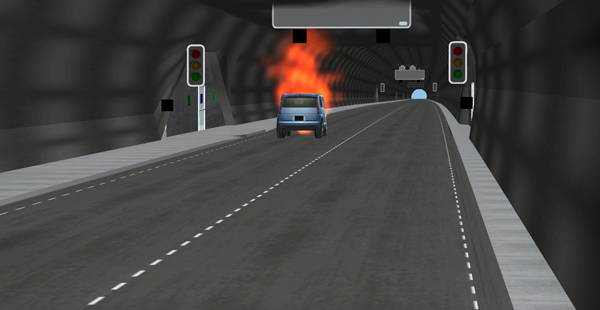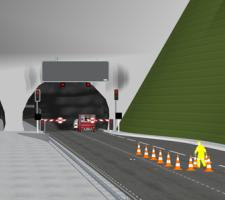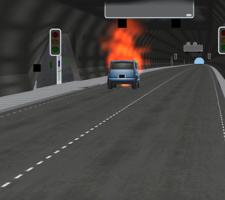
Guillaume Ponsar, tunnel safety engineer with Egis Road Operation, writes about the advantages to be gained from the use of tunnel simulators
Major tunnel disasters over the last decade and more have shown how swiftly and badly a simple crash or fire may evolve should the wrong actions be taken by control room operators or traffic managers. Global safety issues and the reactions of operations staff have now become the principal concerns for Operations and Maintenance (O&M) service providers. As a result, new tools have been developed which are designed to help operators increase safety levels.The use of simulators is an innovation which is aimed at improving operators' skills and providing new solutions to complex situations.
Operating a motorway and/or a tunnel is a complicated undertaking. Many pieces of equipment and procedures are necessary to enable operators to effectively manage the assets.
Each and every piece of that equipment must be mastered by suitably skilled control room operators and other relevant staff. Elaborate procedures must also be developed to coordinate the actions of internal and external staff; these must be very well understood, practiced and tested, particularly by control room operators.
Operator training: prerequisites
Control room operators must train constantly to a high level to ensure their effectiveness within a tailored organisation. Any training programme must therefore include a wide range of skills and competencies, including both a general understanding of operating systems as well as knowledge about the specific asset. Mastery of the Supervisory Control And Data Acquisition (SCADA) system and equipment are the primary concern but knowledge of internal procedures is also an important part of the training.Theoretical training and learning are not sufficient, however. Operating a tunnel or a motorway requires the combination of several different skills such as communication and reporting, situational analysis, confidence, selfcontrol and stress resistance.
In the case of fire in a tunnel, or an accident along a motorway involving several vehicles with injuries, smoke behavior, jet fan management and communication with public services and other stakeholders must be well mastered.
These types of skills can be trained, taught and assessed with the help of a simulator.
Safety simulator solution
With the aim of training its control room operators and staff whilst keeping the assets and control room equipment always available for operation,The simulator is composed of three main stations.
The first station represents a complete SCADA system including all functionalities found in a real control room. The humanmachine interface allows command and control of a full range of equipment in a realistic environment: screens; keyboards; programmable logic controller; Automatic Incident Detection (AID) alarms; and so on. Screen video walls allow the operator to monitor the entire network.
The tool simulates all kind of equipment that a traffic control room operator may have to use: Variable Message Signs (VMS); video cameras with AID; traffic counting stations; barriers; gas detectors; thermometric cable and so on.
Each piece of equipment, available in 3D reality, is able to feed the SCADA system with various data. Through this SCADA system, the control room operator can directly intervene in the 3D reality, to change messages on VMS, manage smoke in the tunnel bores, effect lane closures. The full range of interventions can be simulated.
The operator also benefits from communication systems such as phones, radio and calls from emergency shelters.
Interaction with public services can also be simulated by voice generators.
The second station is a driving simulator with a steering wheel and pedals. This is used to assess patrol personnel's interventions at any location on the 3D network. As with his or her colleague(s) in the control room, the patrolling officer is immersed in a situation very close to reality: upon arriving on site with a safety vehicle equipped with flashing lights and beacons, the patroller can simulate the appropriate actions, such as management of traffic, first actions with fire extinguishers or catching stray animals.
The third station is the trainer's station which manages the whole simulator. In this way, the simulated environment is flexible, allowing the trainer to vary (for instance) the number, type and availability of equipment, or the weather conditions on the network. From the third station, the trainer prepares training exercises and scenarios that will be launched during the training sessions.
GUI upgrade for Caldecott Tunnel
The Caldecott Fourth Bore Project is a four-year, $390 million project to build an additional bore at the Caldecott Tunnel on State Route 24 through the Oakland Hills in California, USA.
State Route 24 passes through the Oakland Hills between Oakland and Orinda, carrying about 160,000 vehicles per day through the three existing bores. Four lanes approach the tunnel in each direction, but each bore only provides two lanes - meaning that one direction of traffic (eastbound or westbound) will be favoured with four lanes, while the opposite direction must merge into two lanes.
The new bore will be built to the north of the three existing bores and will eliminate the need to reverse the direction of the traffic in what is currently the middle bore, something that is done twice a day on weekdays and several times a day on weekends.
topXview will control all of the new bore's subsystems and will integrate with those already in place. The Caldecott Tunnel implementation will include a new graphical user interface which will fully integrate the tunnel's video systems.
Users will be able to drag and drop images onto the video wall or any monitor, something which is usually a keyboard function. The new feature, says Telegra, has been designed to remove the need to scroll through functions and so significantly speed operational tasks and information sharing.
Scenarios available include a slow vehicle, breakdown, injured users, fire and smoke, objects on the carriageway, or roaming animals. The trainer always remains the 'master' of the training session. Indeed, depending on the trainees' behaviour and the procedures being followed, the trainer can adapt the scenario to evolve towards an improving or worsening situation.
Egis Road Operation's solution is a 'standard simulator' that approximates an operating company, including all kinds of equipment and assets available on typical motorways and tunnels. It is important to note that the objective is not to train the trainees on their specific human-machine interface and specific asset, but to provide them with general principles and best practices which exist in control rooms: communication; stress resistance; return of experience; application of appropriate behavior and so on.
Advantages of simulation
Using a simulator is an efficient support tool to theoretical training, procedures learning, table-top exercises and assessment that are the basic elements of staff training but which must be completed with live exercises.In the pre-operational phase, a simulator may be used to familiarise operators with their future job and procedures. Training sessions can therefore take place without the need to access assets.
In the operational phase, a simulator allows training in situations close to reality but without asset mobilisation. This is a particularly important point for tunnels which are often traffic hotspots and where the opportunities to close for training are limited. Moreover, maximum lane availability is often required in new operating contracts, which rarely allows O&M services providers to close assets in order to organise live exercises.
The simulation tool can also be used to 'replay' a real event that occurred in the past, in order to make the event familiar to operators and better manage the same type of event in the future. This replay feature contributes to the overall knowledge of the entire staff and enhances the level of overall safety.
Using a simulator allows the trainees to learn procedures, to test them and eventually to make mistakes in their application. The briefings and return on experience given by the trainer after a session has been performed also adds significant value.
When using a simulator, trainees are immersed in a 3D reality and face different events, incidents and accidents. These 'virtual' situations put trainees in a closeto- real-life situation where the same issues and difficulties of a real incident must be dealt with (including communication, equipment failures or blind spots caused by smoke, for example). This degree of realism enables control room operators, as well as patrollers and their on-call managers, to experience highly pressured situations. A simulator is the only way to increase the reliability of the operator in handling realistic crisis situations, including stress. In this way, the operator's behaviour can be easily assessed during his or her training.
In conclusion, a traffic and safety simulator enhances the overall level of services by increasing asset availability as well as the operator's ability to manage and operate a motorway or a tunnel with full confidence in its management procedures. The end result is that the operating company's safety is significantly improved.













